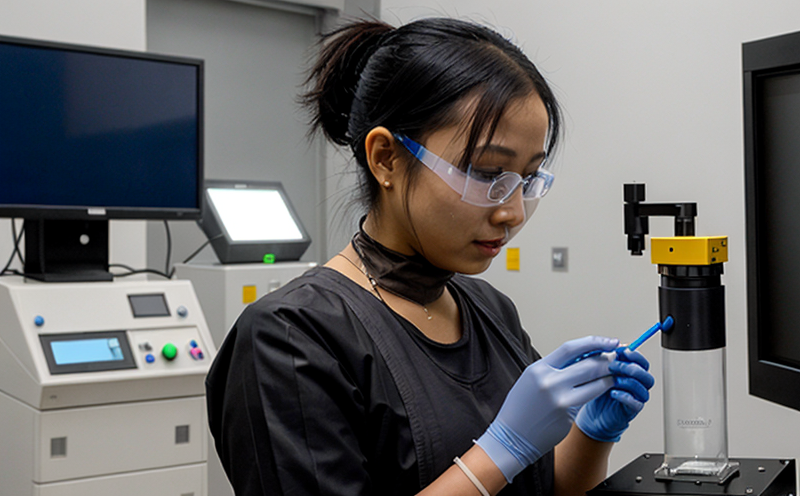OECD TG 203 Fish Acute Toxicity Testing of Nanomaterials
The OECD Test Guideline (TG) 203 provides a standardized approach to assessing the acute toxicity of nanomaterials towards fish. This test is critical in environmental risk assessment, particularly for understanding potential impacts on aquatic ecosystems during the manufacturing and disposal phases.
Acute toxicity testing evaluates how quickly and severely a substance affects an organism when it comes into contact with that organism directly or via water. For nanomaterials, this can be especially important as their small size confers unique properties that may not be observed in larger particles of the same material.
The OECD TG 203 test is designed to mimic real-world conditions where a nanomaterial might enter aquatic environments. It involves exposing fish to solutions containing different concentrations of the nanomaterial and observing mortality rates over a specified period. The test typically runs for up to four days, during which detailed observations are made regarding fish behavior and health.
Preparing specimens for this test requires careful handling to ensure accurate results. Fish used in such tests should be healthy, well-fed, and acclimated to the laboratory environment. The nanomaterials need to be dispersed into water at appropriate concentrations that reflect environmental exposure scenarios. This dispersion process is crucial as it affects how the material interacts with the aquatic medium.
The test setup itself involves maintaining the fish in controlled conditions within specially designed containers that mimic natural water parameters like temperature, pH, and dissolved oxygen levels. Monitoring these parameters ensures that any observed effects are attributed to the nanomaterial rather than changes in environmental conditions.
Data collected from this testing includes mortality rates at various exposure concentrations, as well as behavioral changes such as reduced activity or abnormal swimming patterns. These data points help determine no-observed-effect concentrations (NOEC) and lowest-observed-effect concentrations (LOEC), which are key metrics for risk assessment.
The OECD TG 203 is widely recognized internationally due to its rigorous methodology and reproducibility across different laboratories. Compliance with this guideline ensures that test results can be compared reliably, enhancing confidence in regulatory decisions regarding the environmental safety of nanomaterials.
This testing method plays a vital role in ensuring compliance with various regulations aimed at protecting aquatic ecosystems, including those established by the European Union and other global bodies. It supports informed decision-making processes within industries involved in nanotechnology research and development, helping to minimize potential risks associated with introducing new products into the environment.
Quality and Reliability Assurance
The quality and reliability of results from the OECD TG 203 are paramount for accurate environmental risk assessments. Quality assurance (QA) measures include rigorous training of personnel handling specimens, adherence to strict protocols throughout every stage of the experiment, and regular calibration of instrumentation used in monitoring water parameters.
Reliability assurance focuses on minimizing variability between repeated experiments conducted under identical conditions. This involves standardizing sample preparation procedures, ensuring consistency in experimental setup, and implementing robust quality control checks at key stages of the test.
Data validation is another crucial aspect of maintaining high standards. Independent verification of results through replicate testing or comparison with established data sets helps confirm accuracy and precision of findings. Furthermore, ongoing reviews of methodology and equipment updates ensure that all aspects of the test remain current and effective.
By implementing these QA practices, laboratories conducting OECD TG 203 tests can provide trustworthy and reliable data essential for regulatory compliance and public trust.
International Acceptance and Recognition
The OECD TG 203 enjoys widespread recognition and acceptance globally. Regulatory authorities around the world often require or recommend adherence to this guideline when evaluating potential environmental impacts of nanomaterials. For instance, the European Union's Registration, Evaluation, Authorization and Restriction of Chemicals (REACH) regulation specifies that companies must submit data from OECD-approved tests as part of their registration dossier.
Similarly, in North America, the Environmental Protection Agency (EPA) encourages use of this test for assessing aquatic toxicity of nanomaterials. International standards bodies like ISO and ASTM also reference the OECD TG 203 in their guidelines, further emphasizing its importance within the scientific community.
The global acceptance of the OECD TG 203 is not just limited to regulatory requirements but extends to academic research and industry practices as well. Many leading universities and research institutions incorporate this test into their curriculum and ongoing studies, while major corporations rely on it for product development and quality assurance processes.
By ensuring compliance with this internationally recognized guideline, laboratories demonstrate their commitment to maintaining high standards of scientific integrity and environmental responsibility. This recognition enhances the reputation of both individual laboratories and broader industries associated with nanotechnology research and applications.
Why Choose This Test
- Inclusion in OECD Guidelines: The OECD TG 203 is part of a globally recognized set of guidelines, ensuring consistent and reliable results across different laboratories worldwide.
- Rigorous Standardization: This test provides a standardized approach to assessing nanomaterial toxicity, reducing variability between studies.
- Predictive Value: By mimicking real-world exposure scenarios, the OECD TG 203 helps predict potential environmental impacts accurately.
- Compliance Assurance: Adhering to this guideline ensures compliance with international regulations on nanotechnology and environmental safety.
- Credibility: Results from this test are widely accepted by regulatory bodies, enhancing the credibility of your research findings.
- Advanced Methodology: The use of controlled environments allows for precise measurements and interpretations of data collected during the experiment.
- Precision in Risk Assessment: This testing method provides critical information needed to assess risks associated with nanomaterials, aiding informed decision-making processes.
- Supporting Innovation: By identifying potential hazards early on, this test supports safer innovation within the nanotechnology sector.





